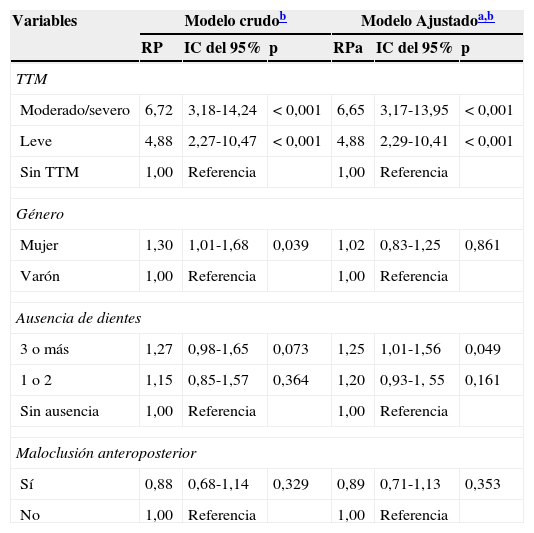Estimar la asociación entre la maloclusión y el trastorno temporomandibular (TTM) con la cervicalgia en los pacientes que asistían al área odontológica de una clínica de Odontología.
Materiales y métodosSe realizó un estudio de corte transversal en Lima, Perú. La población fue conformada por pacientes que asistían a una clínica odontológica, a quienes se evaluó el autorreporte de cervicalgia en los últimos 3 meses, el TTM con el índice de Fonseca, los tipos de maloclusión con la evaluación odontológica registrada en su historia clínica, así como hábitos orales y falta de piezas dentarias. Se evaluó la asociación calculando las razones de prevalencia ajustadas (RPa).
ResultadosSe incluyó a 215 personas, cuya edad media ± desviación estándar fue de 33,1±12,4 años y la mayoría fueron mujeres (69,3%). La prevalencia de cervicalgia fue del 64,2; el 79,1% tuvo algún grado de TTM y el 97,7% maloclusión. Tener TTM estuvo asociado a cervicalgia, tanto moderada como severa (RPa: 6,65; IC del 95%, 3,17-13,95), como leve (RPa: 4,88; IC del 95%, 2,29-10,41). No se halló asociación entre maloclusión y cervicalgia (RPa: 0,89; IC del 95%, 0,71-1,13). Otro factor asociado fue la ausencia de 3 o más dientes (RPa: 1,25; IC del 95%, 1,01-1,56).
ConclusionesLa cervicalgia está asociada al TTM pero no a la maloclusión, por lo que se recomienda un trabajo coordinado entre odontólogos y fisioterapeutas en el manejo de la TTM y cervicalgia para tratar integralmente a estos pacientes.
This study has aimed to estimate the association between malocclusion and temporomandibular disorder with neck pain in patients seen in the area of odontology in an Odontology clinic.
Materials and methodsA cross-sectional was performed in Lima, Peru. The population was composed of patients attending a dental clinic. During the last three months, assessment was made of self-reported neck pain, the temporomandibular disorder (TMD) with the index of Fonseca, types of malocclusion with dental assessment recorded in their medical history, oral habits and lack of teeth. The association was evaluated by estimating the established prevalence reasons (RPa).
ResultsThe study included 215 people, whose mean age was 33.1±12.4 years old. Most of the subjects were women (69.3%). Prevalence of neck pain was 64.2%, 79.1% had some degree of TMD and 97.7% malocclusion. Having TMD was associated with neck pain, both moderate as severe (OR: 6.65, 95% CI: 3.17-3.95) and mild (OR: 4.88 95%, 95% CI: 2.29-10.41). No association between malocclusion and neck pain (95% CI: 0, 71-1, 13 OR 0.89) was found. Another associated factor was the absence of 3 or more teeth (OR: 1.25, 95% CI 1.01-1.56).
ConclusionsNeck pain is associated with TMD but not with malocclusion. Therefore, a coordinated work between dentists and physiotherapists in the management of TMD and neck pain is recommended in order to comprehensively treat these patients.
Artículo
Si ya tiene sus datos de acceso, clique aquí.
Si olvidó su clave de acceso puede recuperarla clicando aquí y seleccionando la opción "He olvidado mi contraseña".Comprando el artículo el PDF del mismo podrá ser descargado
Precio 19,34 €
Comprar ahora











